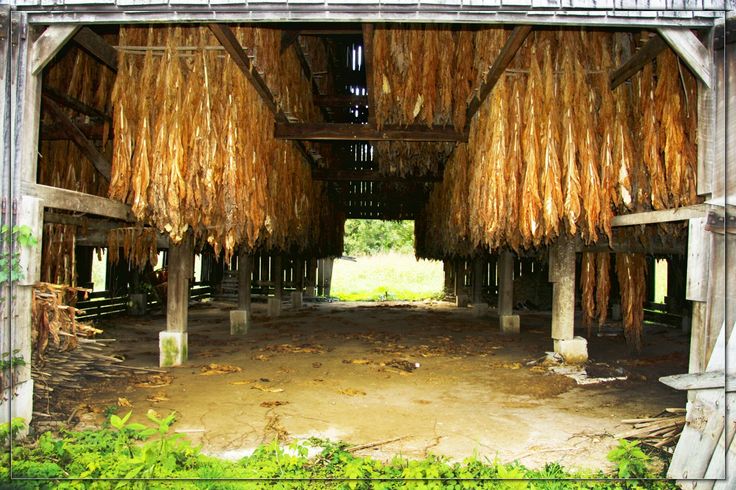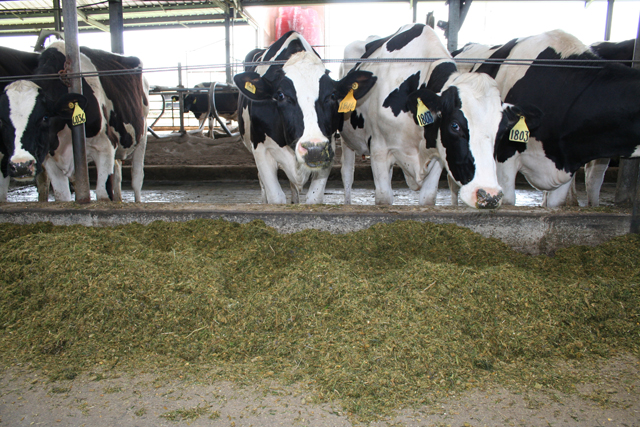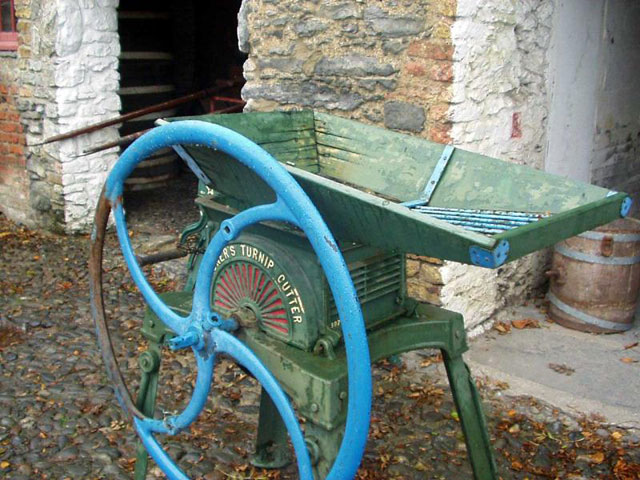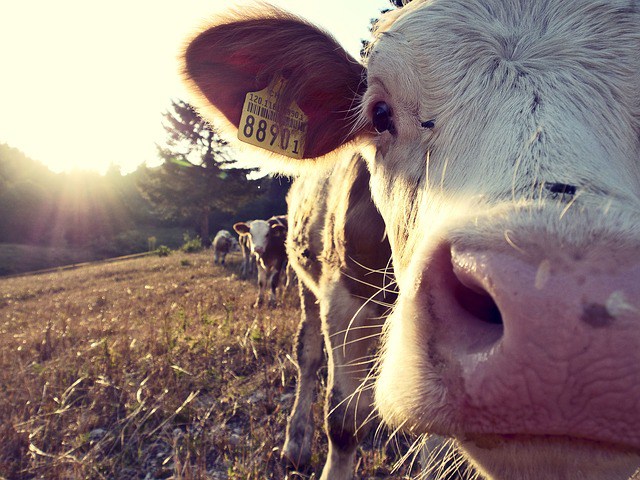
One of the hardest cords to cut for homesteaders is dependence on commercial feeds. Our modern livestock – even a lot of the dual-purpose homesteading breeds – are accustomed to certain types of feeds, heavy on mass-production monoculture grains and hay. Sometimes planting options seem limited, sometimes storage space is at a premium, and sometimes we struggle to figure out what folks did before Buy’N’Large made kibble and meal mix cheap and accessible. There is no one way to do anything, and no solution is going to work for everyone. However, I’ve put together some ideas for root vegetables and their tops that can cut some of our feed bills and feed dependency and alternative or “forgotten” ways of storing and using grains, legumes that might help cut feed costs and increase resiliency and self-sufficiency.
The methods here can be applied from sprawling homesteads to suburban homes and lots. Some of the tips actually apply to humans, too, especially the storage tidbits. There will be another article on alternative livestock feeds that will have even more help for smaller lots with livestock like rabbits and a couple of ducks or goats, and will also include some alternatives that are feeding people and animals on a larger scale in other parts of the world.
Corn Storage
Corn can be collected sweet or allowed to dry on the stalk for grinding and feed types, and an awful lot of livestock is happy with rough-grind “cracked” corn. Dry corn can also be soaked overnight to become more palatable and attractive to livestock. Natives used to dry corn on mats, both shucked and rubbed from the cobs or still attached to cobs, and colonists regularly had stacked racks that allowed good airflow beneath a roof for further drying before corn is transferred to a bin. Corn will keep better (stay dryer) if it’s left on the cob. Leaving the cob on can be space consuming, however. White folks have traditionally used large silos and smaller cribs for dry corn. Once it’s dried on the stalks, husks that have been left on can also be braided into ropes or wider bands, then suspended from ceilings in barns, cellars or homes. Birds and rats are still a risk, but it can be a space-saving way to store corn compared to old-style cribs, since it can go right over our heads, livestock heads, or additional storage areas.
Common grass grains
For households that are putting in limited amounts of grass grains like wheat, barley and oats, each square foot is precious. When there are small amounts, such as turning one or a few 5’x20’ plots and 5-10 pounds of seed into 40-65 pounds of grain or next-year’s planting-for-consumption stock, it’s incredibly important for that seed to dry properly. On a small scale, the cost of specialty machinery may not be available, especially at first, despite the time it can save.
Old-school stooking of stalks helps get them up into the air and at least somewhat away from some pests. However, if a corn bin has drying racks, or there’s a shed with wide doors and enough power to run a box fan, heads can also be cut from the stalks after bundling into stooks, and the bundles hung upside down in tiers, similar to old tobacco barns or even overhead in homes and barn walkways. Doing so cuts down on the amount of floor space needed while protecting the grains from rain, and increases protection against pests.
Old tobacco shed (braided corn or inverted grain bundles can be stored from racks and chains as tobacco once was)
Storing corn and other grains overhead, even once bagged, can save space on the floor and shelves for harvests of apples or* potatoes, autumn and winter squashes, yams, and sweet potatoes, or for jarred and dehydrated produce.
* Potatoes and apples in the same space will make each other ripen/rot faster, but pears, yams and sweet potatoes get along like white on rice with pretty much all other crops once they’ve had their cure period. Since grain storage is ideally dry–dry, crops that like bins of damp sawdust and sand like carrots and turnips aren’t really great sharing space with corn, oats, barley, teff, buckwheat, or any other grain.
African grains
Millet and teff are incredibly difficult and time consuming to mill, but poultry can handle them easily without that step. Teff also makes a good hay and an excellent straw. The major advantage to the relatively rare teff is that this African crop is accustomed to some pretty harsh conditions, nutrient-depleted soils, and hand- and low-mech harvest. Millet is largely seen in game plots and songbird feed, but has plenty of nutritional value and some of the millets can handle pretty much any conditions. Both millet and teff are available in varieties can be had for serious clays, droughts, flood-drought, and saturated field tolerances, which can make them a huge asset for small homesteaders trying to cut feed-store cords.
Millet and corn kernels can also be turned into a type of silage for storage, or the entire still-green plant can be used – as can other grains, legumes, and leafy plants.
Silage
Silage is basically a type of fermentation that produces a high-moisture feed. Haylage and oatlege are basically just specialty types of silage. Brits produce a version called balage. In World War II, farmers sometimes used silage made from turnip and rutabaga tops to help get their breeding pigs and cattle through spring.
It can be created small-scale in heavy-duty contractor or special-purpose bags, in kegs and casks, by round-bale equipment and covers, or in bins from 5-10’ stock tanks to pits and shelters measured in meters. The green matter is chopped, packed down in layers, and covered. Sometimes something absorbent and lightweight like finished straw or chaff is added on top or a sweetener like honey or molasses or tree syrup is used in the layers. The important part of any silage process is to press out the oxygen, and to cover it against reintroduction of oxygen and precipitation.
Cows munching on silage.
Silage can be beneficial in that the starting moisture content is very high. A hay harvest that would be ruined by dews and rains can still become safe animal feed by converting it to silage instead.
It’s not pretty, but just like it got some of our heritage and rare breeds through World War II, in a disaster, the waste-not, want-not aspect of using the tops of storable feed and food crop, “ruined” hay crop, or a grain crop that isn’t going to get all the way to our frosts and freezes to feed our livestock may make it worthwhile for some raisers.
There are naysayers on the topic of silage as animal feed, so do research about the nutrients of various components and methods. Ducks and turkeys can’t have it and I haven’t seen a horse willing to chomp in, but most goats, cattle, pigs, chickens, rabbits, and donkeys could have at least part of their diets replaced, putting that much less pressure on hay and grains for winter and spring.
Roots & Tubers – Swedes, Beets, Sweets, Yams, Radishes and Turnips
Along with pea hay and straw, something farmers haven’t done in a while is maintain big stacks of root veggies along with their tall stacks of hay and straw, or keep tubers in big cellars to haul to their calves, rams, and steers. Forking forage turnips and swedes to cattle and pigs used to be just part of daily life, especially early in winter, and it wasn’t uncommon even up until the 1950s for British farmers to shred or grate swedes to a consistency we’d use for drying apples or potatoes, then use it for weanling cattle and goats, or “slop” them for their meat chickens and pigs.
Image – Turnip slicer from WWII
Britain’s farming directives in response to World War II offers us a fair number of clues for hard-times livestock feeding, and one of the other fabulous nuggets that came out of it was the cooking of slop for pigs. Cooking makes things like potato and sweets and yams safe to eat, skin to “meat”, and boiling allows things like junk meat from pest animals to be included.
Although they aren’t as traditional, most of the cellar- or pit-worthy long-storage root crops like African yams, Chinese yams, and sweet potatoes can be used the same way for our vegan livestock (oca can be used for some livestock in low quantity, but those New Zealand and South American “yam” is a gas-producer capable of twisting up even goats and pigs). They tend to be low on protein, they aren’t the calorie powerhouses of grains, but they work well for stud stock, meat stock, un-bred stock, and things like rabbits and chickens that convert leafy foods efficiently.
Forage and sugar beets and turnips can be had relatively inexpensively as deer plot and pasture-improvement seed. Daikon-type radishes are available in the same genres, but some of the field-improving radishes are bred to produce a spongy biomass and then dissolve in a pretty short amount of time, so we need to pay attention to what we purchase.
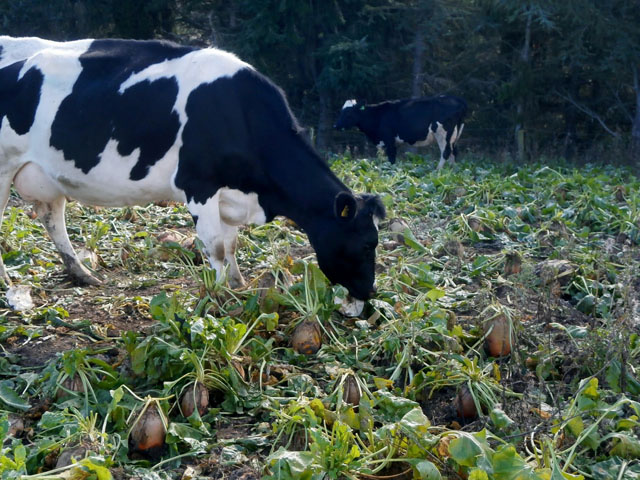
Image – Dairy cattle on forage beets.
Some livestock will eat a daikon radish as-is, but some will pass it unless it’s been boiled – and it’s as much animal-to-animal as it is species or breed. Introducing new foods should progress slowly, but livestock that is regularly exposed to a variety of foods is more likely to nibble something new when it’s mixed in with the old favorites.
Things like sweet potatoes, radishes, turnips and beets are double winners, because both the tops and the roots are edible – for us and for livestock. They can either be grazed early and allowed to develop roots later with pasture rotation, pigs can be rotated in after goats and cattle to dig up tubers (not sweets), tops can be culled and delivered to livestock as green food a little at a time to avoid serious stunting where climates are less forgiving and then the roots can be harvested, or tops can be removed and fed or added to silage when the tubers are being harvested.
Some of the root veggies are ideal to grow in spring, others in the heat of the year. With yams and sweets on the Southern summer end of the spectrum and swedes and Daikons on the shake-off-frosts end, there’s a livestock augmentation in the root crops for pretty much everything but ducks, horses and turkeys. Even donkeys can chomp into some cooked radishes, yams and sweets along with their hay.
*Ducks can nibble some, but they aren’t really supposed to be grazers; they really need grain seeds and more proteins than root veggies provide.
Apples and Pears as Fodder
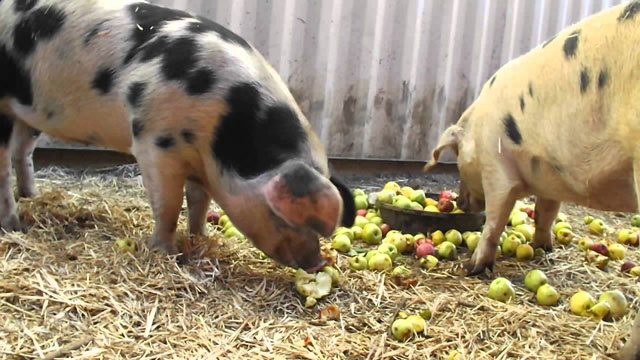
Images – Hogs on apples
Chickens and hogs have historically been scrap compactors, turning odd ends and wilted produce into nummy bacon and eggs, but, again, evolution means they’re not quite as good as it as they used to be. Look for foraging-capability in breed and lineage descriptions (sometimes in percentages and sometimes a rating system), and try to buy from people who at least partly pasture raise their livestock.
Goats, sheep and cattle will chomp into apples, pears and plums as well as the chickens and pigs that go ga-ga for them, but chickens and hogs can handle a higher amount of sweet fruit in their diet. Chickens can also easily handle crabapples and wild plums. Using even just windfall and wormy fruit from existing trees or planting some storage and needs-to-cure apples to our tree fruit can help increase the amount of nutrients and calories we produce on our property, especially if we’re able to situate chickens and rabbits under the canopy – stacking our food production into an even smaller footprint.
Extra bonus: Most meat stock that is finished on apples, pears or beets ends up with really excellent flavor once it’s in the pot. At least a week, but up to a month with a diet supplement or change in those directions can make a huge difference. They still need access to hays while finishing. In Southern climes where sweet potatoes will grow in abundance between traditional crabapple and wild plum hedges, they can have the same effect on hogs, lambs, kids and chickens, making for some seriously succulent eats.
Growing & Storing Livestock Feed
Another article is in the works looking at alternative livestock feeds, things that go even further out on a limb than turnip-top silage and researching African grains and tubers (like tree hay and tree fodder options, and boosting protein for game birds and young chicks).
Even with more traditional foods and feeds, we can start impacting our livestock costs by looking back at history to see what was used – and how – before we depended on fuels and electricity for delivering kibble. We can learn a great deal especially looking at hard times when farmers and small raisers had to make due with limited feed options, such as in Great Britain during World War II and Cuba during the initial months and years of the oil embargo. Those methods can help us figure out how to cut costs and how to develop a sustainable plan for our modern livestock should we ever need it.
As mentioned, modern livestock – even the heritage breeds to some degree – has half a century or more of the Green Revolution under its belt. They are accustomed to pressed and formed feeds in large part, the condensed calories of grains. Modern livestock is largely built for enormous feed conversion, which may be slowed or delayed with certain types of feed, and in many cases, they won’t have correct gut microflora to immediately switch to something new. Always keep good stock records of production and feed, and always transition feeds slowly for livestock, especially small and young livestock.


